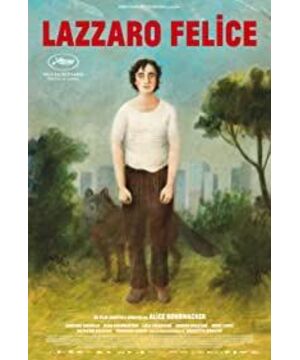Text | Zou Diyang
Insects rustling, the sun is shining brightly, and the water is rippling, this is the consistent geographical perception of Italy. Mentioning the Apennine Peninsula, which is rich in products and rich in humanities, always reminds people of long poems with religious myths as the background. In last year's hit "Call Me by Your Name", Guadagnino accurately reproduced the beautiful Mediterranean scenery in the original book with a classic and ironed lens. Andre Acimonte wrote a large number of vibrant texts, supplemented by the nostalgic graininess unique to 35mm film, impregnating the midsummer scene that makes countless people dream about. This highly coordinated and unified image characteristics, in addition to the unique phenological environment of the location, is naturally due to the director's rich experience and strong intuition in image scheduling.
After watching "Happy Lazzaro", my thoughts fell into a deep pool again, like the protagonist lost in the cracks of time, the psychological tremors during the viewing process gradually stopped, aphasia, along with the sound of the escaped pipe organ, Escape in the drooping night. However, such a psychedelic immersive experience does not wrap people in a high-density intimate atmosphere like the former, but separates them from the complicated and intertwined clues and leads to another kind of strange and open inspection. If CMBYN entrusts the first love as perfect as an ancient Greek statue, then Lazaro's bizarre journey from the pastoral to the metropolis, from the past to the future, is more like a deep metaphor. The edges and corners of time and space were largely erased here, leaving only a few unexpected whispers.
The film is in many respects in the same vein as director Lovalcher's first two works, "The Holy Body" and "Miracle": the skillful use of natural light, the surreal ending of the finishing touch, but the most outstanding is her formula of Italian folklore and nursery rhymes. , the wonderful inspiration extracted from it. In terms of revealing the theme, the film is intentionally split into two parts. The first half of the film depicts a secluded rural beauty like a peach blossom garden with a poetic picture, which contrasts with the dark line of the revival of the tenant peasant system. feel. And after the voiceover about the story of the saint and the hungry wolf was settled, the core of the narrator's intention to write became clearer: Lazaro, the symbol of the "good man", fell off a cliff and woke up at the bottom of the valley. Lu is a traveler who has witnessed the dislocation of time and space and the vicissitudes of life. He is also a son of virtue who was banished by two seemingly completely different civilizations, a desolate and happy martyr.
At this point, the rendering of the class order in the original environment is coming to an end. Although the main line of the film is not yet clear, it is more like a series of fragmented and unrelated plots: the peasants and the manor who are increasingly numb due to the enslavement of the tobacco industry. The status of the Lord is very different, and their fate is like a mayfly shaking a tree. At the beginning of the film, the overwhelming prisoner of the power contract is identified by a pair of young lovers whose elopement is blocked. The image of the Marquise has two meanings here: the monopoly of profit production, and the censor of thought and behavior. Under the discipline and restraint of his own power over the sky, no matter the limited resistance of the villagers or the "kidnapping" farce planned by the noble son, it is like riding a lonely boat against the waves. Significant steering and propulsion.
And just as the commercial reality show in "Miracle" introduced issues related to the modernization process in a timely manner, Lovalcher also arranged the role of police officers who were opposed to "tradition" in his new work. It was their seemingly abrupt visit that broke the Years of stagnation and silence in the village have dragged this corner on the edge of civilization into a concrete forest. At this time, the film jumped out of a pure class allegory and rose to a confusing fantasy, paving the way for a series of style transitions in the second half, including scenes, photography, and sound effects.
It should be pointed out that many directors like to give images a richer and progressive sense of hierarchy through segmentation processing. However, when the script lacks a smooth and self-consistent logic to tie the internal structure of each part, it will make the film appear obviously disconnected and broken. Fortunately, Lovalche can always use convincing skills to place his point of view on the characters overflowing with aura, filling the gap left by the narrative take-off. The little girls in "The Eucharist" and "The Miracle" have extremely pure and delicate hearts, free from worldly dross. Back in this film, the key character is Lazaro.
To this world, Lazzaro is like Jessomina, who has experienced ups and downs in Fellini's "The Road", but is still kind-hearted. Explain more. As the incarnation of purity and goodness, his existence is more like an intangible and unrealistic reference, including the face and tone of the characters, which are indistinguishable from the gods in the painting, which happened to correspond to the poster with the texture of oil painting. As friends chattered about returning home, he sat in the moonlight and wept silently, like a weeping Madonna.
Maybe it was touched by the melody scattered in the night sky, maybe it was pity for the fate of my friend Tancredy, or maybe it was stinged by the cold words and deeds of the world... The answer is impossible to verify, the only thing that is certain is that when the weather changes In the changing world, the senses that carry memories will eventually be dulled, and the companions who used to get along day and night have become strangers beside the railway tracks, just like an imaginative scene in the film: the villagers gather around the window at night, looking into the distance. The faint red light that flickered on and off, guessed that it was a torch lit in the palace. As the story switches to the second act, the true meaning of the light source becomes clear to the public: the signal tower symbolizing the wonder of modern industry, and the series of external changes (the evolution of civilization, the demise of class) that it alludes to. In contrast to these dynamic characteristics, is the The original sin that cannot be washed away in the depths of human nature, and Lazaro's always bright and clear eyes.
Against the backdrop of the perfection nurtured by this local environment, the city where the villagers poured in collectively is like a suffocating prison that gathers bankruptcy and fraud. Faced with the disintegration of global capital giants and refugees scattered all over the world, the director did not put out the ideological slogan head-on, but used breathing film images to let the audience follow Lazaro's footsteps and shuttle through the conflict. Chaos Country is indirectly integrated into the discussion and discussion of realistic issues. Such a poetic and unusually vivid technique shows that on the basis of inheriting the mantle of his predecessors, his bold and mature exploration of his own author's style, after colliding with women's unique soft and perceptual perspective, instantly bursts out a kind of simplicity but not lightness. , full but not empty vitality. No wonder that in today's highly politicized Cannes Film Festival and outdated proposition creation, such a universal warning oracle can break through geographical and cultural constraints and make everyone deeply moved.
At the end of the film, Lazaro was beaten to death by the mob in the bank. His figure turned into a wolf, and ran in the traffic with the sacred organ music, as if there was a residual temperature in the turbid world, which embodies people's desire for the existence of light. fantasy. In the author's opinion, compared to constructing such a miracle that seems like a fantasy, the creator's real intention is to inspire people outside the curtain to think consciously. What we are doing today is worthy of Lazaro's persistence. Pay? In other words, can a world that is farther and farther on the road of strife and division really provide shelter for such clumsy goodness?
I cannot answer this poignant question, but I can only quote a few lines from Baudelaire's "Flowers of Evil", which are reserved as the best and most reverent wishes to all the pure creatures in the world:
I love to recall those undisguised years
Holy youth/look simple
The face is sweet/clear and bright eyes are like flowing water
View more about Happy as Lazzaro reviews










